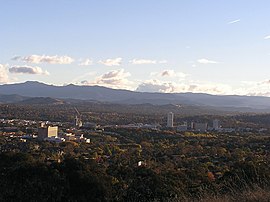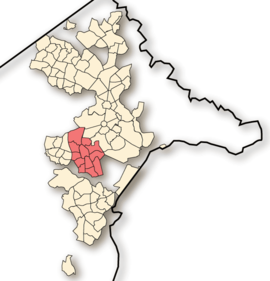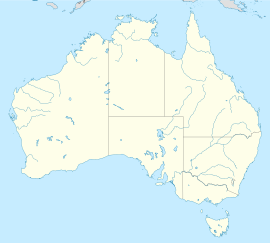| Woden Valley Australian Capital Territory | |||||||||||||||
|---|---|---|---|---|---|---|---|---|---|---|---|---|---|---|---|
 Woden Valley from Red Hill looking across the suburb of Garran in the foreground to the Brindabella Ranges. The Canberra Hospital is to the left and the Woden Town Centre is to the right in the middle distance. | |||||||||||||||
 Location of Woden Valley in the Australian Capital Territory | |||||||||||||||
 | |||||||||||||||
| Coordinates | 35°20′43″S 149°05′42″E / 35.3452°S 149.095°E | ||||||||||||||
| Population | 39,279 (2021 census)[1] | ||||||||||||||
| • Density | 1,373.4/km2 (3,557/sq mi) | ||||||||||||||
| Gazetted | 12 May 1966[2] | ||||||||||||||
| Area | 28.6 km2 (11.0 sq mi) | ||||||||||||||
| Location | 7 km (4 mi) S of Canberra | ||||||||||||||
| Territory electorate(s) | Murrumbidgee | ||||||||||||||
| Federal division(s) | |||||||||||||||
| |||||||||||||||
Woden Valley (/ˈwoʊdɪn/) is a district in the Australian Capital Territory in Australia. The district is subdivided into divisions (suburbs), sections and blocks.
The name of Woden Valley is taken from the name of a nearby homestead owned by James Murray who named the homestead in October 1837 after the Old English god of wisdom, Woden.[3] He named it this as he was to spend his life in the pursuit of wisdom.[citation needed] However, historian Harold Koch considers that the name may have its origins in the Aboriginal word for possum, either wadyan or wadhan, influenced in interpretation by the term known to English speakers of 'Woden'.[4]
In 1964 it was the first satellite city to be built, separate from the district of Canberra Central. It has its own shopping centre, employment opportunities and accommodation with twelve suburbs arranged around the Woden Town Centre. At the 2021 census, the population of the district was 39,279.[1]
- ^ a b Australian Bureau of Statistics (28 June 2022). "Woden (SA3)". 2021 Census QuickStats. Retrieved 6 September 2022.
- ^ "Districts Ordinance 1966 No. 5 (ACT)" (PDF).
- ^ Wilson, Gwendoline. Murray of Yarralumla. p. 81.
- ^ "How did the town centre of Woden come to be named after a Norse god?". ABC News. 6 September 2017. Retrieved 15 October 2017.
